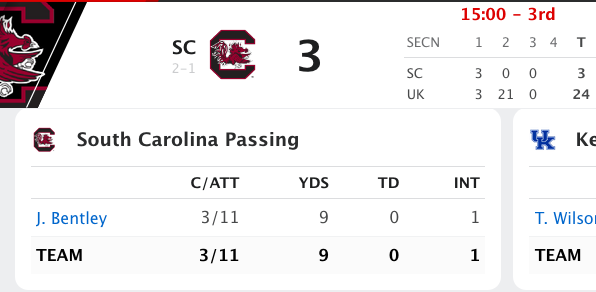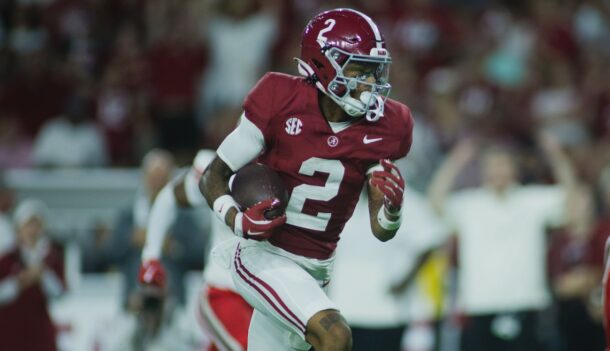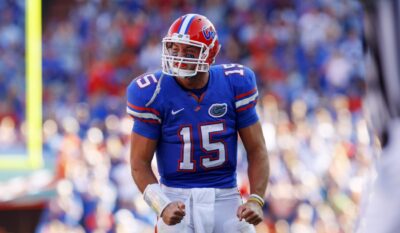
QB Curve: Joe Burrow has raised the bar at LSU. Can he get the Tigers over it?
By Matt Hinton
Published:
Quarterbacks: There are a lot of them! Each week, QB Curve will keep you up to speed on the game’s most important position by putting a different SEC signal-caller in the spotlight and putting the rest of the field in perspective. Previously: Tua Tagovailoa vs. Jalen Hurts … Jake Bentley … Jordan Ta’amu … Drew Lock … Jarrett Guarantano
QB of the Week: Joe Burrow
Typecasting: The Man of the Hour
Nothing else exposes the transactional nature of modern college football as efficiently as the annual scramble for quarterbacks on the grad-transfer market, and when Burrow arrived at LSU this summer he made no pretense that the move was anything but business: He needed a new opportunity to get on the field after losing the competition to start at Ohio State; LSU just happened to be hanging a “Help Wanted” sign on the depth chart after watching its heir apparent behind center, sophomore Myles Brennan, fail to emerge in the spring.
The vacancy was a major reason the Tigers faced their lowest preseason expectations in nearly two decades. To skeptics, their late-breaking bid for a former Big Ten castoff to fill it — one whose basic profile was more or less indistinguishable from the former Big Ten castoff he hoped to replace — only served to confirm that the concerns were real. To Burrow, it was just the opening he was looking for.
One month in, business is picking up. LSU is 5-0 with two top-10 victims, Miami and Auburn, already on the board, and boasts a top-10 ranking of its own. Burrow is entrenched and coming off his best performance of the young season, a 388-yard, 4-touchdown effort against Ole Miss that earned him the title of SEC Offensive Player of the Week for the second time in three weeks. (He also got the nod after leading the Tigers’ comeback win at Auburn.) Ed Orgeron has graduated, at least temporarily, from hot-seat mainstay to prime candidate for a raise. For now, LSU looks reassuringly like LSU is supposed to look, with all of the usual benchmarks for a big year on the table.
But September, as encouraging as it was, is over, and as quickly as the momentum shifted in the Tigers’ direction over the first month of the season, the coming month has the potential to snuff it out: This weekend’s trip to Florida is the first game in another heavy-hitting stretch that includes dates with Georgia and Alabama on either side of a visit from Mississippi State. Key questions still loom, none more urgently than whether Burrow — whose popularity in Baton Rouge right now vastly exceeds his production — is really all he’s cracked up to be. So far, so good. Now the stakes start to get real.
The good
The first priority of all LSU quarterbacks is to do no harm, and Burrow has fulfilled that mission so far with zero interceptions in 131 attempts. (He has lost a pair of fumbles against Louisiana Tech and Ole Miss, although neither led to points.) Nationally, the only other Power 5 conference starter yet to throw a pick this year is Tua Tagovailoa, who has attempted significantly fewer passes.
And while Burrow’s output is thoroughly mediocre according to most conventional measures (see the next section), that’s at least partly due to the fact that two of his five outings so far have come against top-shelf defenses.
Adjusted for competition, he fares a lot better: In ESPN’s Total QBR metric, which takes the schedule into account, Burrow ranks 20th nationally; that’s good for third in the SEC, behind Tua and Drew Lock. Only Lock and Ole Miss’ Jordan Ta’amu are accounting for a higher individual share of their team’s total offense …
Individual Share of Team’s Total Offense* (SEC leaders through Week 5)
1. Jordan Ta’amu (Ole Miss): 65.6%
2. Drew Lock (Missouri): 62.6%
3. Joe Burrow (LSU): 59.4%
4. Kyle Shurmur (Vanderbilt): 58.9%
5. Jake Bentley (South Carolina): 58.3%
6. Feleipe Franks (Florida): 56.6%
7. Kellen Mond (Texas A&M): 56.1%
8. Jarrett Stidham (Auburn): 51.5%
– – –
*Passing and rushing yards (including negative yardage on sacks)
… and they’re both throwing the ball significantly more often in offenses that emphasize tempo and downfield passing. LSU is more spread-friendly these days than it has been in the past, but all in all remains one of the most run-oriented attacks in the conference. For a pocket-oriented quarterback in a scheme that still employs a fullback on a regular basis, that’s a significant number.
It’s also arguable that, in terms of his size, arm strength, and pocket savvy, Burrow already looks like LSU’s most NFL-ready prospect behind center since Zach Mettenberger, if not longer. In part, that’s because he’s quickly earned a reputation for affecting the game in ways that don’t necessarily show up on film or in the box score: After the season-opener, teammates applauded Burrow’s pre-snap intelligence, particularly on a key 4th-down audible that resulted in a 50-yard touchdown run by RB Nick Brossette (among others).
Athletically, there might not be a single, Mettenbergerian throw into the next parish that will leave scouts scrambling to rewind the tape, but there are enough of the intermediate, stand-and-deliver kind of strikes — square-ins, digs, the coveted play-action from under center — that will always put a 6-3, 220-pounder on their radar.
9/2/18 — LSU's Joe Burrow 22-yard pass complete to Jamarr Chase vs. Miami pic.twitter.com/9VOFaOddas
— College Football Clips (@CFB_Clips) October 3, 2018
Burrow’s two most explosive plays of the season have both come on essentially the same throw — a 20-yard cross-country rout to a receiver who started out on the opposite side of the field — albeit out of different formations and in very different circumstances. The first, of course, was the SEC’s biggest play of the year to date, a 71-yard rope to Derrick Dillon (still, incredibly, Dillon’s only catch of the season) that ended an extended drought against Auburn and sparked the eventual comeback:
9/15/18 —LSU's Joe Burrow 71-yard touchdown pass to Derrick Dillon vs. Auburn pic.twitter.com/iO9jue2zsd
— College Football Clips (@CFB_Clips) October 3, 2018
The second, a 65-yard catch-and-run to Justin Jefferson that marked LSU’s fourth touchdown in as many possessions against Ole Miss, was slightly less dramatic, and much, much easier:
9/29/18 — LSU's Joe Burrow 65-yard touchdown pass to Justin Jefferson vs. Ole Miss pic.twitter.com/jSSZVYTl8Q
— College Football Clips (@CFB_Clips) October 3, 2018
For his size, Burrow is also a sneakily effective runner who has been productive in the red zone, as a third-down scrambler, on short-yardage plunges, and especially on the zone read, which yielded a 35-yard TD run to cap the scoring against the Rebels.
That was the longest run by an LSU quarterback since 2014, and served notice to opposing defenses that they can’t afford to ignore Burrow as a potential threat on the ground. At his current pace (30.8 yards per game on 4.4 per carry, including sacks), Burrow will post easily the best rushing output of any Tiger QB since Jordan Jefferson in 2010.
The not-so-good
Much of the hype surrounding Burrow so far revolves around “intangibles” — his leadership, his second-generation smarts, his grit in the clutch — because the numbers tend to tell a different story. Statistically he’s struggling: Factoring in his white-hot stat line against Ole Miss, Burrow still ranks 12th among SEC starts in completion percentage (he came into the game slightly below 50 percent for the season) and 10th in overall efficiency. On third downs, he’s averaging a dismal 4.2 yards per attempt with a passer rating that ranks among the worst in the nation.
Compared to the rest of the conference, just keeping the sticks moving has been an uphill battle:
Percent of All Passes Resulting In 1st Downs (SEC starters through Week 5)
1. Tua Tagovailoa (Alabama): 51.1%
2. Jake Fromm (Georgia): 47.3%
3. Kellen Mond (Texas A&M): 38.5%
4. Drew Lock (Missouri): 38.5%
5. Kyle Shurmur (Vanderbilt): 35.9%
6. Feleipe Franks (Florida): 35.7%
7. Jake Bentley (South Carolina): 35.6%
8. Jarrett Guarantano (Tennessee): 35.5%
9. Jarrett Stidham (Auburn): 33.9%
10. Jordan Ta’amu (Ole Miss): 33.7%
11. Terry Wilson (Kentucky): 32.3%
12. Joe Burrow (LSU): 29.7%
13. Ty Storey (Arkansas): 26.4%
14. Nick Fitzgerald (Miss. State): 25.5%
– – –
Minimum 80 attempts
Lapses in accuracy have led to a few extended cold spells. Against Miami, LSU’s offense scored to go up 17-3 early in the second quarter and didn’t find the end zone again (although the defense did, on a pick-six), finishing with a paltry 296 total yards; Burrow ended the game by missing on 7 of his last 11 attempts from that point on.
Against Auburn, LSU scored on its first possession (thanks in part to a short field following an interception) and didn’t reach the end zone again until well into the fourth quarter; in between, Burrow was 8-for-23. On the game-winning drive itself, his crowning moment of the opening month, he was just 2-for-6 for 17 yards, not including a pair of borderline pass-interference penalties that accounted for the majority of the yardage on that drive.
In fact, even in terms of QBR — which, again, is far kinder to him than the conventional numbers — Burrow has benefited from more expected points added via penalties than any other FBS passer. If not for a couple of those flags the narrative surrounding both him and his team right now would likely be very different.
The takeaway
On paper, Burrow has yet to surpass his less-than-decorated predecessors in any obvious way, statistically or otherwise. He led a lopsided neutral-site win to open the season? So did Danny Etling last year. Improbable, come-from-behind win over Auburn? Danny Etling did that, too. Impressive stat line in a blowout win over Ole Miss? Etling has been there. If LSU prevails Saturday in a slugfest with Florida, yep, you guessed it. Other LSU quarterbacks who have overseen a 5-0 start or better this decade include Brandon Harris, Zach Mettenberger, Jarrett Lee and Jordan Jefferson. If this position has been a liability in the pursuit of championships, even Burrow’s biggest fans can’t yet declare him an obvious asset.
Still, for a team that was widely picked to finish in the bottom half of its own division, it says something about something that a championship is even on the table.
The Tigers don’t have an All-American workhorse in the backfield a la Jeremy Hill, Leonard Fournette, or Derrius Guice, and (as of right now, anyway) don’t boast a top-10 defense in any major category. They’re just average overall on third downs and in the red zone. They have just one defensive TD, and haven’t scored on a kickoff or punt return. In that context, the guy who’s accounting for nearly 60 percent of the total offense for an undefeated team averaging almost a touchdown more per game than it did last year is always going to come in for a lot of love.
How much any of that matters going forward is another question. The good vibes to date are largely relative to the unusually grim forecast coming into the season; as the expectations rise into loftier territory — territory LSU fans usually have the luxury of taking for granted — it’s not at all clear yet whether Burrow is any better equipped to clear that bar than the Etlings and Mettenbergers were in the past.
As much as the Tigers’ outlook has improved over the past month, ESPN’s Football Power Index still projects them as underdogs in three of the next four games, and the season finale at Texas A&M as a toss-up. Their chances of winning out are 0.2 percent (i.e. zero); chances of winning the conference, 1.9 percent. That’s after beating two top-10 opponents away from home.
At this point, it’s safe to say LSU fans are hoping for more than yet another season that takes them from the Top 10 to the Outback Bowl. It’s to Burrow’s credit that he’s given them reason to hope. But actually bringing it to fruition will mean achieving a level they haven’t seen from him so far, or from anyone else in his position in a long time.
QB Curve Power Hour!
Ranking the league’s starting quarterbacks heading into Week 6.
1. Tua Tagovailoa, Alabama. Tua went 8-for-8 with a pair of TD passes in a thorough beatdown of UL-Lafayette, wrapping up about as perfect an opening month as any quarterback in recent memory. The most pressing question going forward: Can he kick? (Last Week: 1)
2. Jake Fromm, Georgia. It was impossible to watch Fromm’s 5-star understudy, Justin Fields, close out the win over Tennessee and not imagine a regular, run-first role for him off the bench like the one Tim Tebow played as a true freshman in Florida’s national championship run in 2006. Fromm’s not in any danger of being edged out of the starter’s seat anytime soon, but Fields brings too much to the table in the zone-read game — an aspect of the offense where Fromm is basically a nonentity — to continue to relegate him to garbage time. (LW: 2)
3. Drew Lock, Missouri. Mizzou had last weekend off to lick its wounds after getting trounced by Georgia, but this week’s trip to South Carolina is arguably a bigger game to get the season back on track. Last year’s meeting with the Gamecocks was one of Lock’s worst outings of the year. (LW: 3)
4. Jarrett Stidham, Auburn. The o-line has been the more obvious culprit in Auburn’s offensive struggles the past two weeks; for the year, Stidham continues to lag well behind last year’s pace in every category. (LW: 4)
5. Joe Burrow, LSU. This might be an overcorrection for ranking Burrow too low up to this point; frankly the dissonance between LSU’s overall success and his own middling stat line leaves me as conflicted about his place in the pecking order as any QB on this list. A trip to The Swamp should tell us a lot more. (LW: 10)
6. Kellen Mond, Texas A&M. Mond has been picked twice in each of his past two games, but when one of those games is against Alabama and the other is against Arkansas it doesn’t mean quite the same thing. Time to tap the brakes on his ascent for a week or two. (LW: 6)
7. Jordan Ta’amu, Ole Miss. The Rebels’ next two opponents are UL-Monroe and Arkansas, so Ta’amu could be on the rise against soon after a couple rough nights against Bama and LSU. (LW: 7)
8. Nick Fitzgerald, Mississippi State. Fitzgerald has looked wretched in losses to Kentucky and Florida, inviting speculation about his future with promising sophomore Keytaon Thompson waiting in the wings. Thompson hasn’t faced a defense in his career on the level of the ones that have wrecked Fitzgerald’s senior season the past two weeks, but at the rate things are going the transition is only a matter of time. (LW: 5)
9. Feleipe Franks, Florida. Franks seems to have turned the corner as a redshirt sophomore from basket case to a guy who gives the Gators a fighting chance in slugfests. Right now Dan Mullen seems intent on playing as many of those as possible. (LW: 11)
10. Jake Bentley, South Carolina. Almost halfway through his junior year the book on Bentley remains the same: Enormous talent, lackluster production. His output in the first half of Saturday’s loss at Kentucky was beyond abysmal:

Bentley finished with 3 picks in a 24-10 loss that wasn’t nearly as close as that score indicates, which is not where his career was supposed to be at this stage. (LW: 8)
11. Kyle Shurmur, Vanderbilt. The Commodores’ 31-27 win over Tennessee State was the weirdest game of the weekend, one in which both offenses combined for six trips inside the opposing team’s 30-yard line that resulted in no points. Two of those drives (Vandy’s first two possessions) ended with interceptions off Shurmur, who rallied to finish 18-for-22 with 3 touchdowns over the rest of the game. (LW: 9)
12. Terry Wilson, Kentucky. It’s obvious by now that Wilson is not going to consistently threaten defenses with his arm. With Kentucky’s defense and ground game, it’s not obvious that he needs to for the Wildcats to reach 10 wins. (LW: 12)
13. Jarrett Guarantano, Tennessee. Guarantano delivered the weekend’s most misleading box score, somehow posting an efficiency rating of 150.5 against Georgia in a game in which Tennessee punted on all five of its first-half possessions and trailed 24-0 before finally getting on the board. (For context, that number is nearly on par with Baker Mayfield’s 156.1 rating against Georgia in last year’s Rose Bowl.) A pair of futile second-half TD passes distorted another nondescript performance. (LW: 13)
14. Ty Storey, Arkansas. Well, Storey is undeniably the Razorbacks’ starter now, having gone wire-to-wire in two consecutive games after being stuck in a revolving door over the first few weeks. Under the circumstances that will have to suffice as progress. (LW: 14)
Matt Hinton, author of 'Monday Down South' and our resident QB guru, has previously written for Dr. Saturday, CBS and Grantland.







